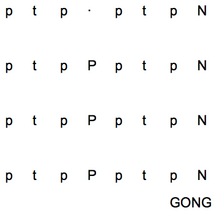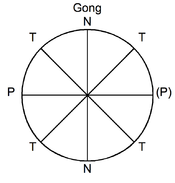Colotomy

Colotomy is an
The details of the rhythmic patterns depend on the colotomic structure (Javanese: bentuk), also known as gendhing structure. There are a number of different structures, which differ greatly in length and complexity; however, all of them have some colotomic characteristics.
In the gamelan, the instruments which articulate this structure are sometimes called the colotomic instruments (also interpunctuating instruments or structural instruments, while Lindsay refers to them as "phrase-making instruments"
History and usage
The
Although the term "colotomic" was derived from Indonesian music theory, it can be applied to other musical traditions as well. In particular, it has been used to describe Japanese gagaku and Thai piphat.[7]
Example of a colotomic structure
The
TWTN TPTN TPTN TPTG
where T indicates the strike of the
Colotomic structures occur on even larger scales in most gamelan pieces as well. For example, a typical lancaran has four gongs,[clarification needed] at the end of which the larger gong ageng is played. Groupings of four are most common at all levels of structure, although there are numerous exceptions at larger levels.
The colotomic structure of a piece is the length of the cycle and how the interpunctuating instruments play during that cycle, but they are also musical forms which are associated with specific structural patterns on a larger scale than the colotomic cycle, and guidelines for what tempi and irama may be used.
Colotomic structures in Javanese gamelan
Colotomic structures or Gendhing structure refers to the colotomic structure of gamelan compositions in general. Gendhing (also written, as in the old orthography, gending) can also be used to refer to a specific class of colotomic structures used in Javanese gamelan music.
At its simplest, colotomic may be taken to mean, "cyclicly punctuating".
Most gendhing in Javanese music conform to one of these structures, except for some special ceremonial pieces and experimental new compositions.
General
Colotomic structures from the general repertoire.
Gendhing
Gendhing is the longest and most complicated of the gendhing structures. It is typically played in a slow
Gendhing have two parts, a
For an example of the gendhing structure, consider "gendhing kethuk 2 kerep minggah kethuk 4." This means that in the merong, there will be two kethuk strokes that happen on odd-numbered gatra, and in the minggah, there will be four gatras per nongan. The structure would then look like:
Merong:
...T .... ...T ...N...T .... ...T ...N...T .... ...T ...N...T .... ...T ...G
Minggah:
pTp. pTp. pTp. pTpNpTp. pTp. pTp. pTpNpTp. pTp. pTp. pTpNpTp. pTp. pTp. pTpG
where "." indicates no interpunctuating instrument plays, p indicates the stroke of the
and kenong. Thus, in each section, the gong plays once, the kenong divides that into four parts, and then that is divided into parts according to the given structure. Here, in each part, each nongan lasts 16 beats (keteg), and thus the gongan lasts 64.That was a fairly short example; a "kethuk 4 arang" merong, for example, would look like:
.... ...T .... .... .... ...T .... .... .... ...T .... .... .... ...T .... ...N.... ...T .... .... .... ...T .... .... .... ...T .... .... .... ...T .... ...N.... ...T .... .... .... ...T .... .... .... ...T .... .... .... ...T .... ...N.... ...T .... .... .... ...T .... .... .... ...T .... .... .... ...T .... ...G
and thus a nongan would last 16 gatras (64 beats), and a gongan 64 gatras (256 beats). Obviously, in a long structure like that, especially at a slow tempo, a single gongan may last many minutes.
The merong section may include a
Between the merong and inggah is a bridge section called the ompak. Typically it has the length of one nongan, and a contrasting balungan melody to the merong.
Ketawang

T = kethuk, P = kempul, N = kenong, Gong = gong ageng.
The ketawang is one of the gendhing structures used in Javanese gamelan music.
Its colotomic structure is:
pTpW pTpN pTpP pTpG
where p indicates the strike of the
Ketawang usually have the specific form of an
The ketawang developed in the court of Prince Mangkunegara IV (r. 1853–1881) of Surakarta.
Famous ketawang: Puspawarna.
Lancaran
The lancaran is one of the
Groupings of four are most common at all levels of this structure. The basic
TWTN TPTN TPTN TPTG
where T indicates the strike of the
Lancaran are usually played fast, usually in
Bubaran are played more moderately, usually in
Gangsaran is a variety of lancaran which consists of simply a repeated tone. It originates from the wayang repertoire. It can appear at the end of a composition as well.
Ladrang

The ladrang is one of the
music.The basic
pTpW pTpN pTpP pTpN pTpP pTpN pTpP pTpG
where p indicates the strike of the
The ladrang is similar to the
Many ladrang have two sections, an ompak and a ngelik, each of which typically last one gongan. Ladrang can be played in any irama except for lancar.[11]
Wayang
In
.Ayak-ayakan
The ayak-ayakan is one structure.
The colotomic structure is:
...P ...PTNTN TNTN
with both lines played together, and T indicating a stroke of the
It usually begins in
The ayak-ayakan is often used to accompany the entrance of puppets, or the transition between pathets.
Sampak
Sampak is another structure. A sampak often follows a srepeg. It is the fastest of the wayang structures.
The colotomic structure is:
NNNNNNNN NNNNNNNNTPTPTPTP TPTPTPTP
with both lines played together, and T indicating a stroke of the
Example
Sampak
2222 3333 77777777 2222 66666666 3333 2222- Suwuk:
xx22
This sampak has three gongan. The signal to end can come at any gong, where the player plays the next two notes as normal, and then 22 (as indicated by xx22).
Srepeg
Srepeg is another colotomic structure:
...P...P ...P...PTNTNTNTN TNTNTNTN
with both lines played together, and T indicating a stroke of the
.It is usually fast and played in
See also
Notes
- ^ ISBN 0-19-588582-1.
- ^ Lindsay (1992), p.10.
- ^ Lindsay (1992), p.14.
- ISBN 9780955029509.
- ISBN 9781851095063.
- ^ Malm, William P. (1977). Music Cultures of the Pacific, the Near East, and Asia, 2nd ed. Englewood Cliffs, NJ: Prentice Hall. Page 43.
- ^ Malm, 123 and 194-195.
- ISBN 9780549702917.
- ^ ISBN 9780226792835.
- ISBN 0131823876.
- ^ a b c Sorrell, Neil (1990). A Guide to the Gamelan, p.68-69. London: Faber and Faber.
Further reading
- Neil Sorrell. A Guide to the Gamelan. London: Faber and Faber, 1990. Page 67–73.
External links
- Michael Tenzer. Excerpt from Balinese music describing colotomic structures in Balinese music (subscription required)


